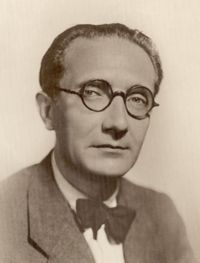The directory «Plots»
Castelao Alfonso Daniel Rodrigues
(1886—1950)

Alfonso Daniel Rodríguez Castelao is one of the main symbols of Galicia (in Spain). As a politician, caricaturist and writer, he is one of the leading figures of Galician culture and identity. Although born in Galicia, he spent his childhood and adolescence in Santa Rosa de Toay, Argentina. The Castelao family returned to Rianxo in 1900, and Afonso-Daniel obtained his degree in Medicine from the University of Santiago de Compostela in 1908. The next year he passed his doctorate in Madrid, where he started to become known as a caricaturist, and settled down in Rianxo, joining the political movement Action Galicia (Accion Gallega in Galician). As a caricaturist, Castelao focussed on the everyday in a humourous way, although after the cruelty and tragedy of the Spanish Civil War, he turned to using his art to denounce the misery of Fascism. In 1916 he moved to Pontevedra, where he joined the Irmandades da Fala and participated in the Asembleia Nazonalista de Lugo, signing an important national declaration. In 1920 he became editor of the magazine Nos and travelled through France, the Netherlands and Germany. In 1922 he wrote the novel Un Ollo de Vidro and in 1924 he joined the Seminario de Estudos Galegos and founded the Coral Polifonica de Pontevedra. Two years later he published Cousas, and in 1929 he travelled to Brittany to study its stone crosses and publish As Cruces de Pedra na Bretaña. In 1930 he founded the Federacion Republicana Galega at Lestrove Palace and participated in the meetings of the Partido Nacionalista Republicano Galego and in the assembly for the Federal State of Galicia. The next year he published Nos and was elected member of the Cortes Generales for the Partido Galeguista, which had 16 deputies. In 1934 he published Retrincos, Os Dous de Sempre and the last edition of Cousas; he entered the Real Academia Gallega before being exiled by the Spanish government to Castille until 1935. Elected again as a member of Cortes for the Partido Galeguista, the Civil War began whilst Castelao was in Madrid giving the results of the referendum for Galician self-government, which was approved by 98% of voters, and in which Castelao had had a very important role. During the war he organised the Milicias Galegas, in which Enrique Lister fought, and followed the Spanish Republican government to Madrid, Barcelona and Valencia, where he published Galicia Martir and Atila in Galicia. In 1938 he was sent by the government to the Soviet Union, the United States and Cuba, in order to obtain support for the Republic. From New York City he cruised to Buenos Aires, where in 1941 he performed for the first time he play Os vellos non deben de namorarse, Castelao's tribute to the Galician theatre. In 1944 he published a seminal work of Galician political theory, Sempre en Galiza, and became the first president of the Consello de Galiza, the Government of Galicia in exile. Together with Catalans and Basques he founded the magazine Galeuzca in 1945, as a reminiscence of the political alliance of 1933, and one year later he became Minister of the Spanish Republican government in exile, living in Paris. Back in Buenos Aires in 1947 and sick with lung cancer, he published As Cruces de Pedra na Galiza and died in January 1950. The Argentine Senate and the City of Buenos Aires erected monuments to honour him. Since then, most of Castelao's work has been translated and published in languages ranging from Hungarian to Chinese. After the death of Spanish dictator Francisco Franco, Castelao was interred in Galicia, at the Panteon de Galegos Ilustres.
Spain, 1986, Alfonso Rodrigues Castelao
Spain, 1986.12.01,  Santiago de Compostela. Alfonso Castelao
Santiago de Compostela. Alfonso Castelao
Spain, 2000.11.20,  Felipe de Castro. Alfonso Rodrigues Castelao
Felipe de Castro. Alfonso Rodrigues Castelao